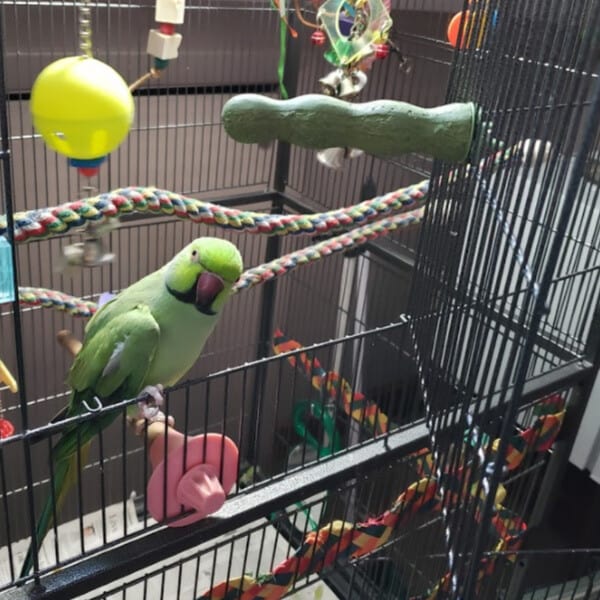
A Better Bird Ep 15 Migrating Recent Ringneck Rescue To New Home Bird Cage – Video
Last Updated on by Catherine Tobsing
[videopress WyYwEiTW]
I can’t count the number of times people inquire about the best way to migrate a bird from an older cage to a new birdcage.
A bird who has had the same bird cage, toys and accessories for 10 or 20 years is a phobic bird that you created.
I’m not sure where the information came from that new birds should be allowed to settle in for a couple weeks and disturb them very little.
Looking at how bird brains work we know (by science) that many species of birds process thought three times faster than mammals (using the speed of neurons as a benchmark)
Birds generally have a standing heart rate of 200 bpm.
Thus we have is incredibly effective performance animal who can fly at speed of wind.
Flap their wings so fast we can’t see the movement.
And we let them settle in, by doing nothing
We let our birds sit and stare outside and wonder why my bird won’t socialize with me?
To overcome a parrots phobias, change on a daily and weekly basis must occur for the bird’s mind to be stimulated.
Almost 2 years after rescuing Peaches our (Senegal who was thrust into I think seven cages were first week with us, did just fine) we rescued a 15-year-old male African ringneck.
When I picked up the bird he was in a cage which was not his own but necessary for him to travel back to Chicago with me.
He spent two or three days in a cage until he got his new permanent home page organized.
Three days later he was traveling in a travel carrier and then would move into his camp cage and are permanently parked travel trailer.
We do this regularly with birds.
We don’t give the birds a chance to refuse.
We don’t allow birds to control us, we control the birds.
This lack of control is one of many high level reasons people fail at captive bird care which leads to overflowing bird rescues around the country.
In answer to questions like, why does my bird bite me?
Why won’t my bird play with his toys?
Why does my bird scream?
Whining to the Internet will not solve your captive bird problems.
Listening and understanding how your bird thinks and predicting reactions at the speed of light should be your goal.
Peaches was rather demure when we got her after spending seven years of her 7 1/2 year-old life in a rescue.
She immediately bonded with me and I was able to move her anywhere on my hand.
The only time she bit me was when Catherine came close because I was her new mate and she was very jealous.
To solve the problem I never have Peaches anywhere on my body when Catherine is closer than 3 feet away – biting problem solved.
With Keto, Catherine discovered early on that Keto would do anything to be near his bell toys.
She uses this for what we call a redirection, taking total control over the animal who no longer thought about lunging or biting – as long as the bell toy was reachable by him.
Using his bell toys she is able to move him in and out of the cages and play with him on her lap.
This is a 15-year-old bird was been our home three weeks.
Probably the third home and most people would consider a bird like this traumatized.
Birds are traumatized by many things for probably the worst is the lack of intervention with humans.
Conclusion
Do you know what your birds hot buttons are?
Do you have items in and out of the birds cage you can use a redirection to get their mind off of attacking your hand or other humans in the home.
We call it “speaking bird,” something easy to learn but without understanding how your bird reacts anything and everything you are setting yourself up for failure.
Author Profile
Latest entries
 The Traveling BirdJune 26, 2025Can You Name 5 Parrot Species That Are Living Wild in the USA?
The Traveling BirdJune 26, 2025Can You Name 5 Parrot Species That Are Living Wild in the USA? Bird BehaviorJune 26, 2025How is it Parrots Are Problem Solvers Social Animals and Even Use Tools?
Bird BehaviorJune 26, 2025How is it Parrots Are Problem Solvers Social Animals and Even Use Tools? Bird & Parrot AnatomyJune 25, 2025How a Tiny Chemical Modification Makes Parrots Nature’s Living Paintings
Bird & Parrot AnatomyJune 25, 2025How a Tiny Chemical Modification Makes Parrots Nature’s Living Paintings PigeonsJune 20, 2025How Do Parrots Thrive in Cities Outside Their Native Habitats?
PigeonsJune 20, 2025How Do Parrots Thrive in Cities Outside Their Native Habitats?


